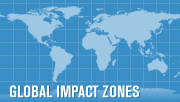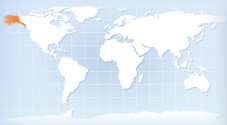Melting ground and sea ice destroying villages

Since the middle of the 20th century, Alaska has warmed 3 degrees Fahrenheit and its winters have warmed nearly 6 degrees. The predictions are even more dire. By the end of the 21st century, Alaska’s annual average temperature is expected to rise by about 8 to 13 degrees Fahrenheit compared to the 1960s and 70s if emissions of greenhouse gases continue unabated. The dramatic temperature changes in Alaska are already causing the landscape to change faster than anywhere else in the United States, threatening infrastructure, wildlife, and Native Alaskan culture.
Alaska: permafrost not so permanent
Alaskan villages, like Shishmaref above, are finding the land they call home literally melting out from underneath them. Warmer winters have allowed the once reliably frozen tundra, called permafrost, to thaw, causing homes and buildings to sink and foundations and roads to crack and warp.
Reduction in protective sea ice and rising sea levels makes coastal villages more vulnerable to storm surges and increased erosion. As global warming changes the contours of Alaska’s coasts, whole villages are confronted with the necessity of relocating inland at a cost of tens of millions of dollars according to an Army Corps of Engineers analysis.
But coastal villages are not the only things at risk in Alaska. Water and sanitation infrastructure throughout Alaska is threatened by thawing permafrost. Structures such as roads, buildings, pipelines, and power lines built on top of permafrost may shift, warp, or collapse as the ground melts and softens. Damage from permafrost thawing, increased flooding and coastal erosion as a result of global warming could add $3.6 to $6.1 billion to costs of public infrastructure in Alaska by 2030.
Even nature’s infrastructure can suffer from melting permafrost. “Drunken” forests occur when permafrost melts leaving trees leaning at odd angles. But tilted trees aren’t the only trouble for Alaskan forests. In many areas, rainfall has decreased, leading to drier conditions and more wildfires. Alaska’s white spruce forests, for example, are already suffering from drought stress. Warmer temperatures have also brought more damaging outbreaks of pests. As trees burn or decompose, they release the carbon stored in them back into the atmosphere.
Ecosystem Changes
Arctic biodiversity is also in danger from global warming and ocean acidification. Significant changes include reductions in seabird and marine mammal populations and declining harvests of salmon on their return to spawning areas. Sea lion numbers have declined between 50 and 80 percent over the last few decades. The polar bear depends on summer sea ice to hunt seals. As the extent of sea ice shrinks so does the polar bear’s habitat. On land scientists have documented a doubling of coastal erosion and lake changes in the last two decades, impacting critical habitat for caribou and migratory birds.
The decline of these iconic Arctic animals impacts the indigenous Alaskan communities since they depend on hunting, trapping, and fishing for subsistence. Beyond the diet and health importance of these activities, they also represent a unique and important part of indigenous cultures. Reduced or displaced populations of marine mammals, seabirds, and other wildlife are combining with the reduced and thinning sea ice to make traditional livelihoods difficult and more dangerous for indigenous Alaskans.



